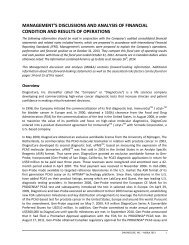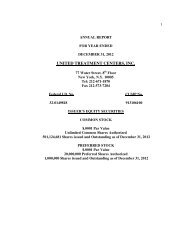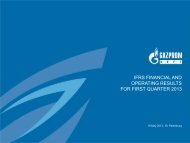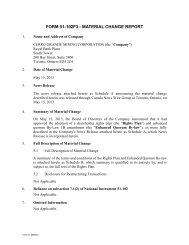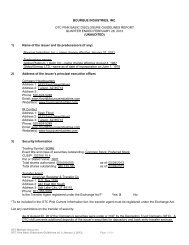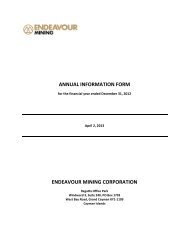2ub8Xn
2ub8Xn
2ub8Xn
You also want an ePaper? Increase the reach of your titles
YUMPU automatically turns print PDFs into web optimized ePapers that Google loves.
Allana Potash Corp.<br />
Management’s Discussion and Analysis<br />
For the three months ended October 31, 2012<br />
regarding the reliability of financial reporting and the preparation of financial statements for external<br />
purposes in accordance with generally accepted accounting principles. A control system, no matter how<br />
well designed and operated, can provide only reasonable, not absolute, assurance with respect to the<br />
reliability of financial reporting and the financial statement preparation.<br />
PEA<br />
This document includes a discussion on the Company’s PEA with respect to the Danakil Potash Project. As<br />
disclosed herein, the Company has, since the date of the PEA, disclosed a new updated mineral resource<br />
estimate for the project. Although the PEA represents useful, accurate and reliable information based on the<br />
information available at the time of its publication, and provides an important indicator as to the economic<br />
potential of the Danakil Potash Project, the PEA is based on mineral resources estimates published in June<br />
2011, which do not reflect exploration conducted since their effective date, and the PEA does not reflect the<br />
latest mineral resource estimate published by Allana on April 30, 2012. Certain assumptions used in the<br />
PEA, some of which relate to the June 2011 mineral resource estimate, may have changed from those used<br />
for the new resource estimate, causing a variation of parameters. Moreover, the updated mineral resource<br />
estimate may have an impact on Allana’s plans on how it intends to develop the deposit.<br />
The PEA is partly based on inferred mineral resources that are considered too speculative geologically to<br />
have the economic considerations applied to them that would enable them to be categorized as mineral<br />
reserves, and there is no certainty that the PEA based on these mineral resources will be realized. The<br />
results depend on inputs that are subject to a number of known and unknown risks, uncertainties and other<br />
factors that may cause actual results to differ materially from those presented here. The reader should<br />
review carefully the technical report, relating to the PEA which can be found on SEDAR at<br />
www.sedar.com.<br />
SIGNIFICANT ACCOUNTING JUDGEMENTS, ESTIMATES AND ASSUMPTIONS<br />
The preparation of these consolidated financial statements in conformity with IFRS requires the Company’s<br />
management to make judgments, estimates and assumptions about future events that affect the amounts<br />
reported in the consolidated financial statements and related notes to the consolidated financial statements.<br />
Although these estimates are based on management’s best knowledge of the amount, event or actions,<br />
actual results may differ from those estimates and these differences could be material.<br />
The areas which require management to make significant judgments, estimates and assumptions in<br />
determining carrying values include, but are not limited to:<br />
� Assets’ carrying values and impairment charges<br />
In the determination of carrying values and impairment charges, management looks at the higher of<br />
recoverable amount or fair value less costs to sell in the case of assets and at objective evidence, significant<br />
or prolonged decline of fair value on financial assets indicating impairment. These determinations and their<br />
individual assumptions require that management make a decision based on the best available information at<br />
each reporting period.<br />
� Capitalization of exploration and evaluation costs<br />
Management has determined that exploration and evaluation costs incurred during the year have future<br />
economic benefits and are economically recoverable. In making this judgment, management has assessed<br />
various sources of information including but not limited to the geologic and metallurgic information,<br />
history of conversion of mineral deposits to proven and probable mineral reserves, scoping and feasibility<br />
studies, proximity of operating facilities, operating management expertise and existing permits. See Note<br />
10 of the consolidated financial statements for details of capitalized exploration and evaluation costs.<br />
32



